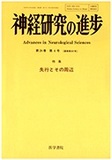Japanese
English
- 有料閲覧
- Abstract 文献概要
- 1ページ目 Look Inside
- サイト内被引用 Cited by
はじめに
失行の機序はLiepmann(1920)によって最初に総括的に呈示された。Liepmannによれば失行には三つの臨床型がある。第一が左右の中心領域(中心溝を挟む前後の領域)病変によって生ずる肢節運動失行,二番目が左側縁上回,上頭頂小葉の皮質と皮質下病変による観念運動性失行,第三が左側角回周辺病変で生ずる観念性失行である。Liepmannはこれら失行症例の臨床症状の観察と剖検病巣との対比から失行の機序に関する重要な事実を数多く明らかにした。その中でもっとも重要な点は左半球病変で両上肢に失行(観念運動性失行,観念性失行)が生ずることから,行為の優位性が左半球に存することを示したことにある。それに加えて,Liepmannは脳梁病変で左側肢の失行(観念運動性失行)が生ずることを根拠に,左大脳半球にある行為機能が脳梁を介して右大脳半球に伝達されることを示し,これらの事実を基底にして失行の機序を数個の図式として提唱した。
失行の機序に関する研究はその後も多数ある。しかし,筆者にはそれらの中にLiepmannの示した図式を超える総括的内容を持つものはないと思える。
A first comprehensive theory on neural mechanism of apraxia was presented by Liepmann (1920) with several schematic diagrams. There have been done thereafter a number of studies on the mechanism of apraxia, none of which though seem to have surpassed the work of Liepmann and its comprehensive content.
In the current article are presented at first some cases of our own exemplifying the validity of the Liepmann's schemata of apraxia, and some comments are made from a new viewpoint.

Copyright © 1994, Igaku-Shoin Ltd. All rights reserved.


